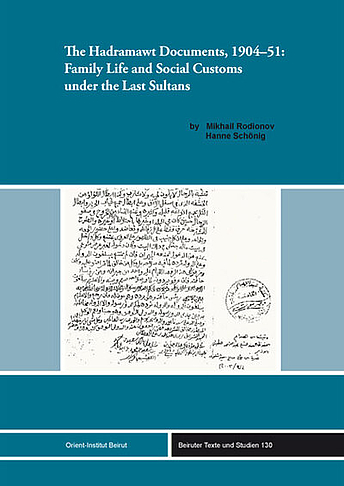Duration: 01.11.2004 -31.10.2006
During a one year’s project in 2003, already supported by the German Research Foundation (DFG), several mostly unpublished texts were collected in Hadramaut, which give information on customs, traditions and everyday culture in a rich local dialectal terminology.
This rich literature of the 19th and 20th centuries gives insight into a spectrum of social norms and practices during a period of transition and change, caused by foreign influences: by the British mandate (1839-1967), by the Soviet Union especially during the existence of the ’Democratic Republic of Yemen’ (1967-1990), but mostly by the migration, especially to South(east)Asia, which is still going on. Material innovations, which have been brought by returning migrants, and an infrastructure which had been built up by the wealth of some ruling families and which could be compared with Western standards, created a new context and new chances for traditional society. Social structures were touched by this change, too: genealogies and social hierarchy, which play an eminent role in this region have undergone important change. The confrontation with new and different objects and concepts has provoked discussion and a re-evaluation of traditions as well as change change – a discourse which is mirrored in different (kinds of) texts.
The immense value of these textual materials, which mirror the intensive economic and social relations between Hadramaut and the regions of migration in South(east)Asia through the centuries, is well known from the scholarly literature as well as from our personal observations.
Since the end of the 1980s in the ’Manuscripts and Documentation Department’ in the sultan’s palace in Sai’un a special collection can be consulted: official documents and correspondences with the sultan of the Kathiri-dynasty (1489-1967), organised in eight subject categories and numbered in a list, give a unique testimony, dated from 1622 on until the end of the sultans’ reign in the end of 1967. A second important source of information are the works of Hadrami scholars and authors, which, however, often are handwritten manuscripts or exist as photocopies only.
Besides the complete set of documents of the category ’customs and traditions’ belonging to the above mentioned collection which refers mainly to marriage customs and dress codes, we have also collected several independent texts on everyday culture and folk medicine as well as most of the publications written by the Hadrami scholar ’Abdalqadir Muhammad as-Sabban (Sai’un, d. 1999), newspaper articles and local publications on Hadramaut which are not available outside Yemen.
As extratextual empirical analysis plays a complementary role in the project, contextual and terminological questions will be discussed in interviews during field research planned for summer/autumn 2006.
Selected texts of the collected corpus are now being translated and commented. An additional analytic wordlist of dialectal termini will complete the study.
The following subjects occurring in the texts are being studied:
- Material aspects of ethnic culture: dress, jewelery, household wares, agriculture
- Rituals in rites of passage: birth, circumcision, marriage, death
- local traditions: ibex hunt, pilgrimage/ visits of saints’ tombs; folk-medicine.
The study is based on documents pertaining to the al-Kathīrī and al-Quʿayṭī Sultanates in Hadramawt (Yemen) and gathered from the al-Kathīrī Archives in Sayʾūn and private collections. The material discussed consists of letters, reports, personal notes, legal opinions and poetry focusing on family life and social customs during the period of cultural changes in the first half of the 20th century. The first part of the book depicts everyday life under the sultans – such as the structure of traditional society, life cycle rites, religious rituals, and everyday customs – with special attention given to the women’s world as pictured in the sources. It also analyses the topics of the documents, their style, structure and design. The second part deals with the documents themselves, which are presented in facsimile, Arabic transcripts and English translation. The annotated vocabulary aims to preserve the disappearing local lexis of the period, often borrowed from South West and South Asia, and elsewhere, unfamiliar today even to most young Hadramis. The fruit of many field seasons in Hadramawt, this book introduces significant primary and secondary texts which contribute to an understanding of a South Arabian culture and society.

~Mikhail Rodionov und Hanne Schönig
The Hadramawt Documents, 1904-51.
Family Life and Social Customs under the Last Sultans.
Beiruter Texte und Studien 130.
Ergon-Verlag Würzburg 2011. Read more about the book.
Prof. Mikhail Rodionov, Head of the Department of South and Southwest Asia, Peter the Great Museum of Anthropology and Ethnography, St Petersburg, Russia
Dr. Hanne Schönig, Centre for Interdisciplinary Regional Studies – Middle East, Africa, Asia (ZIRS), Martin Luther University Halle-Wittenberg, Germany
